OSO-3
Orbiting Solar Observatory-3
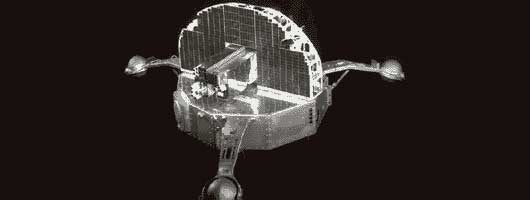
X-Ray Telescope
The UCSD X-ray Telescope on-board OSO-3 consisted of a single thin NaI(Tl) scintillation crystal plus photomultiplier tube assembly enclosed in a howitzer-shaped CsI(Tl) anticoincidence shield. A drawing of the telescope is given below. The telescope was manufactured by Ball Brothers Research Corporation of Boulder, CO.
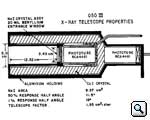 The central detector was 0.5 cm thick with 9.57 cm
2
area and an entrance window of 0.020 inch beryllium to minimize photoelectric absorption of low energy x-rays. The collimation by the CsI shield breaks down above about 170 keV, but still absorbs half of the normally incident photons at 620 keV and half of the 45 degree incident photons up to 1 MeV. Energy loss events in the central crystal greater than 7.7 keV and less than 210 keV, if unaccompanied by an anticoincidence event, were sorted into six logrithmically spaced differential energy channels and two integral energy channels. The six differential channels covered the energy ranges 7.7-12.5 keV, 12.5-22 keV, 22-38 keV, 38-65 keV, 65-113 keV, and 113-210 keV. The two integral channels were >7.7 keV and >210 keV. The energy resolution was approximately 45% FWHM at 30 keV, and increased as energy to the -0.33 power. A long term gain deterioration of the photomultiplier tube increased the effective energy thresholds by about a factor of 3 at the end of one year in orbit.
The central detector was 0.5 cm thick with 9.57 cm
2
area and an entrance window of 0.020 inch beryllium to minimize photoelectric absorption of low energy x-rays. The collimation by the CsI shield breaks down above about 170 keV, but still absorbs half of the normally incident photons at 620 keV and half of the 45 degree incident photons up to 1 MeV. Energy loss events in the central crystal greater than 7.7 keV and less than 210 keV, if unaccompanied by an anticoincidence event, were sorted into six logrithmically spaced differential energy channels and two integral energy channels. The six differential channels covered the energy ranges 7.7-12.5 keV, 12.5-22 keV, 22-38 keV, 38-65 keV, 65-113 keV, and 113-210 keV. The two integral channels were >7.7 keV and >210 keV. The energy resolution was approximately 45% FWHM at 30 keV, and increased as energy to the -0.33 power. A long term gain deterioration of the photomultiplier tube increased the effective energy thresholds by about a factor of 3 at the end of one year in orbit.
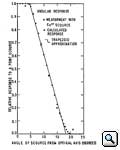 The angular response of the telescope is shown in the accompanying figure. This is a result of an analytic calculation taking into consideration the size of the collimator opening and the detector diameter, as well as the depth of the collimator section. This calculation was compared to measurements in the laboratory with a Co-57 radioactive source with emissionat 122 keV. This was them fitted by a trapazoidal function for analysis purposes. The opening angle is 23 degrees FWHM.
The angular response of the telescope is shown in the accompanying figure. This is a result of an analytic calculation taking into consideration the size of the collimator opening and the detector diameter, as well as the depth of the collimator section. This calculation was compared to measurements in the laboratory with a Co-57 radioactive source with emissionat 122 keV. This was them fitted by a trapazoidal function for analysis purposes. The opening angle is 23 degrees FWHM.
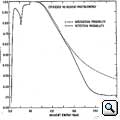 In order to calculate the detector efficiency as a function of energy, one must take into account the various interactions and processes that occur between a photon incident on the telescope and the telemetered value of the energy for that event. This includes absorption by passive material in the beam (such as the beryllium window), probability of photoelectric, Compton scattering, and pair production interaction in the detector, light collection efficiencies, photomultiplier tube gain, and the characteristics of the data system. Also, included is the probability that an iodine K x-ray is emitted and escapes the detector, thereby lowering the measured energy by 29.4 keV. The energy resolution of the detector must also be included in the calculation (sigma(FWHM)=0.65 E
0.67
). When all of this is calculated, generally by a Monte Carlo program, one has the probability of detection as a function of incident photon energy. This is shown to the right for the X-ray Telescope.
In order to calculate the detector efficiency as a function of energy, one must take into account the various interactions and processes that occur between a photon incident on the telescope and the telemetered value of the energy for that event. This includes absorption by passive material in the beam (such as the beryllium window), probability of photoelectric, Compton scattering, and pair production interaction in the detector, light collection efficiencies, photomultiplier tube gain, and the characteristics of the data system. Also, included is the probability that an iodine K x-ray is emitted and escapes the detector, thereby lowering the measured energy by 29.4 keV. The energy resolution of the detector must also be included in the calculation (sigma(FWHM)=0.65 E
0.67
). When all of this is calculated, generally by a Monte Carlo program, one has the probability of detection as a function of incident photon energy. This is shown to the right for the X-ray Telescope.
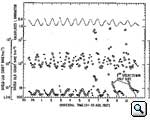 The shield counting rates -- counts/second above 7.7 keV and above 213 keV -- as a function of time for 12 hours in August of 1967 are shown on the left. Also shown is the McIlwain L-parameter, which is a measure of distance from the magnetic equator, and thus of cosmic ray rate, since the instrument is better shielded from cosmic rays the closer it is to the magnetic equator. The earth's magnetic field deflects lower and lower energy charged particles the closer one is to the equator. This is clearly seen in the Figure as a synchronous variation of the rates with the L-parameter. Also seen are large enhancements in the rates near 6:30, 8:00, and 10:00 which correspond to OSO-3 traversing the trapped radiation known as the South Atlantic Anomaly. This is an additional source of high energy charged particles, mostly protons, that increase the shield rates to saturation. These protons also cause a secondary effect -- the radioactive activation of the telescope, especially the iodine in the scintillators. The rates decay away with the characteristic 25 minute half-life of iodine-128. Thus, even out of the Anomaly, the counting rates are enhanced. Other longer lived isotopes are formed which take longer to decay and build up to equilibrium over a month or more.
The shield counting rates -- counts/second above 7.7 keV and above 213 keV -- as a function of time for 12 hours in August of 1967 are shown on the left. Also shown is the McIlwain L-parameter, which is a measure of distance from the magnetic equator, and thus of cosmic ray rate, since the instrument is better shielded from cosmic rays the closer it is to the magnetic equator. The earth's magnetic field deflects lower and lower energy charged particles the closer one is to the equator. This is clearly seen in the Figure as a synchronous variation of the rates with the L-parameter. Also seen are large enhancements in the rates near 6:30, 8:00, and 10:00 which correspond to OSO-3 traversing the trapped radiation known as the South Atlantic Anomaly. This is an additional source of high energy charged particles, mostly protons, that increase the shield rates to saturation. These protons also cause a secondary effect -- the radioactive activation of the telescope, especially the iodine in the scintillators. The rates decay away with the characteristic 25 minute half-life of iodine-128. Thus, even out of the Anomaly, the counting rates are enhanced. Other longer lived isotopes are formed which take longer to decay and build up to equilibrium over a month or more.
OSO-3 Information
Mission Objectives
Spacecraft
X-Ray Telescope
Scientific Results
Publications